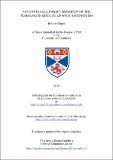Files in this item
A functional characterisation of the PCSK6 locus associated with handedness
Item metadata
| dc.contributor.advisor | Paracchini, Silvia | |
| dc.contributor.advisor | Smith, Terry K. | |
| dc.contributor.advisor | Kent, Lindsey | |
| dc.contributor.author | Shore, Robert | |
| dc.coverage.spatial | xvii, 237 p. | en_US |
| dc.date.accessioned | 2018-07-27T13:29:57Z | |
| dc.date.available | 2018-07-27T13:29:57Z | |
| dc.date.issued | 2016-06-20 | |
| dc.identifier.uri | https://hdl.handle.net/10023/15719 | |
| dc.description.abstract | Humans display a 90% population level bias towards right-handedness, implying the vast majority of people have a left-hemisphere dominant for motor control. Although handedness presents a weak, but very consistent heritability across the literature (estimated to be approximately 25%), to date few genetic loci associated with this complex trait have been identified and replicated in subsequent studies. One such gene which has been found to be associated with handedness and subsequently replicated is PCSK6, most recently through a quantitative GWAS (P < 0.5*10⁻⁸, Brandler et al. (2013)). Interestingly, PCSK6 is known to activate Nodal, a morphogen involved in a highly conserved bilaterian pathway known to regulate left-right body axis determination. Here I present the first molecular characterisation of a handedness-associated region by conducting a detailed functional analysis of the PCSK6 locus, combining genetic analysis, in silico prediction and molecular assays to investigate how common genetic variants influence handedness-related phenotypes. Specifically, I defined the associated locus to be 12.7 kb in size, spanning a predicted 1.8 kb bidirectional promoter which controls the expression of both an antisense long non-coding RNA (lncRNA), and a novel short PCSK6 isoform. A series of luciferase-expressing constructs were generated to characterise the promoter, identifying a minimal sequence capable of driving transcription in a sense strand direction. I have demonstrated experimentally that one of the top associated markers in previous GWA studies, rs11855145, directly creates/disrupts a suspected transcription factor bind site in the vicinity of this bidirectional promoter. Further functional studies of the genetic variation within PCSK6 may help explain the molecular regulatory mechanisms affecting gene expression. This project provides a model for assays to study other GWAS-nominated candidate genes, and in particular for establishing the role of noncoding variants. The findings from this study support the role of common variants in influencing complex phenotypes, such as handedness. | en_US |
| dc.language.iso | en | en_US |
| dc.publisher | University of St Andrews | |
| dc.rights | Attribution-NonCommercial-NoDerivatives 4.0 International | |
| dc.rights.uri | http://creativecommons.org/licenses/by-nc-nd/4.0/ | |
| dc.subject | Handedness | en_US |
| dc.subject | PCSK6 | en_US |
| dc.subject | Nodal | en_US |
| dc.subject | Cerebral asymmetry | en_US |
| dc.subject | Neurogenetics | en_US |
| dc.subject.lcc | QP356.22S5 | |
| dc.subject.lcsh | Neurogenetics | en |
| dc.subject.lcsh | Left- and right-handedness | en |
| dc.subject.lcsh | Cerebral dominance | en |
| dc.title | A functional characterisation of the PCSK6 locus associated with handedness | en_US |
| dc.type | Thesis | en_US |
| dc.contributor.sponsor | University of St Andrews | en_US |
| dc.type.qualificationlevel | Doctoral | en_US |
| dc.type.qualificationname | PhD Doctor of Philosophy | en_US |
| dc.publisher.institution | The University of St Andrews | en_US |
| dc.publisher.department | School of Medicine | en_US |
This item appears in the following Collection(s)
Except where otherwise noted within the work, this item's licence for re-use is described as Attribution-NonCommercial-NoDerivatives 4.0 International
Items in the St Andrews Research Repository are protected by copyright, with all rights reserved, unless otherwise indicated.


